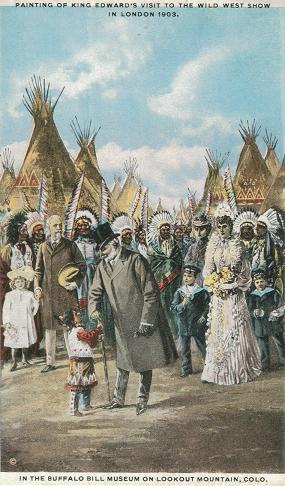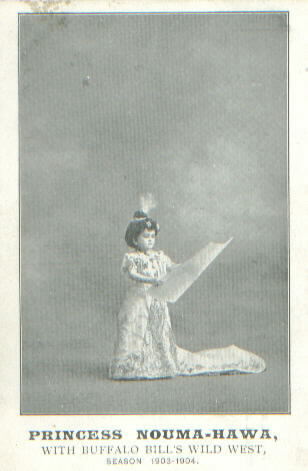

| Home Links Contact |
| 1887-88 1891-92 1892 1902-03 1904 |
|
|
The performers for the 1902-03 season departed New York on board the Saint Louis on 3rd December 1902, arriving at Southampton on the 11th.The Mesaba, bringing horses and paraphernalia used in the show, left New York on 6th December 1902, arriving in London on the 17th. Of the few names entered on the passenger list, I have been unable to identify any as performers; certainly, no Native Americans are in evidence.
Although the Indians recruited for this and the 1904 tour were Pine Ridge Oglalas, Buffalo Bill’s publicity machine consistently misrepresented them as belonging in more or less equal proportion to the Sioux, Cheyenne, Arapaho and Brulé tribes, their horses colour-coded accordingly. The absurdity of this arrangement is compounded by the fact that Brulé is one of the seven constituent subtribes of the Lakota (Sioux) nation. Guiding his fellow tribesmen on this latest adventure was Lakota interpreter Luther Standing Bear.
The season, covering ninety-five different venues and involving 2,881 miles of rail travel in aggregate, unfolded in two distinct stages. A lengthy residency at the Olympia, in the Kensington district of London, commenced on Boxing Day, Friday, 26th December 1902, overshadowed by sad news, for Col. Cody’s long-time business partner, Nate Salsbury, had lost a lengthy battle with a stomach complaint, most probably cancer.

The twenty-two items on the programme on this occasion reflected the settled format assumed almost ten years earlier, Buffalo Bill’s Wild West & Congress of Rough Riders of the World. The tried and tested Western tableaux, such as successive Indian assaults on an emigrant train, the Deadwood Stage and a settler’s cabin, were retained, though now supplemented by international, mostly equestrian items, listed in the standard adverts, with varying degrees of accuracy, as Royal English Lancers, Bedouin Arabs, South American Gauchos, United States Cavalry, Cuban Patriots, Russian Cossacks (actually ethnic Georgians), Roosevelt Rough Riders, American Artillery and Mexican Ruralies. In an arguably ill-conceived attempt to keep up with post-frontier developments, the battle sequence consisted of a representation of the Battle of San Juan Hill of 1898, the decisive engagement of the Spanish-American War in Cuba; although, given the constraints imposed by the flat surface on which performances were of necessity given, without the actual hill. Garbled fragments of the Buffalo Bill legend, in the form of retrospective features, continue to insist that Annie Oakley was a participant on the later British tours. This is an inaccuracy, however; she had sustained severe internal injuries when a show train met with a head-on collision near Lexington, Virginia, on 28th October 1901, towards the end of that year’s tour. Annie eventually recovered sufficiently to resurrect her show career but never again fired a shot for Buffalo Bill.
Another notable absentee from Buffalo Bill’s later tours of Great Britain and Europe was the buffalo herd. The legal provisions regulating the importation and transport of livestock had proven onerous in the past, so that this aspect of the show was wisely deemed to be more trouble than it was worth.
A substantial royal party, led by King Edward VII, drove in five carriages from Buckingham Palace to attend the afternoon performance on Saturday, 14th March 1903. The picture postcard featured opposite reproduces an artist’s impression of an incident during the King’s visit to the tipi village, when a little boy named Moses Red Star is stated to have laid hands upon His Majesty’s umbrella. No doubt the show’s publicity materials, as was generally the case, made more of the episode than it actually amounted to. Certainly, the royal visitor gave no indication that he was by any means offended.
A programme insert, listing twenty-one items, was printed especially for the royal visit. This is similar to the 1903 touring programme, although the sequence in which the various acts were presented is different. Two items are missing from the insert. According to Luther Standing Bear, the Battle of San Juan Hill sequence was omitted to accommodate Queen Alexandra’s aversion to excessive shooting and smoke. The demonstration by the United States Life Saving Corps was also left out on this occasion. There was however one addition, Item 19, apparently a feature of the Olympia stand, though not of the touring programme, consisting of manoeuvres, drill and exercises by the Aurora (Illinois) Zouaves, stated to be making ‘Their first appearance in London’.

The touring arena
The Olympia season closed on 4th April 1903 and was followed after a short break by an extended tour of England and Wales, commencing at Manchester on Easter Monday, 13th April, with shows twice daily, commencing at two o’clock in the afternoon and eight in the evening, every day except Sunday.
The venues selected were centres of population served by effective rail links. These were indispensable, not just for the transportation of the show but also because railway services were the principal means by which spectators travelled in large numbers from the outlying areas.
The Manchester and Liverpool stands were allocated three weeks apiece, Birmingham two and Cardiff and Leeds one. The show appeared in Sheffield over four days; Bristol, Plymouth, Portsmouth and Brighton, three; Reading, Swansea, Southampton, Leicester, Bradford and Nottingham two but the overwhelming majority of venues were for one day only. No doubt the Indians, with their longstanding tradition of nomadism, provided at least a part of the inspiration but the crucial expertise which made this important development possible was provided by James Bailey, of the Barnum & Bailey organisation, who had been assumed as a partner in 1895. Barnum & Bailey owned the special trains in which the vast entourage of 800 people and 500 horses travelled from one venue to the next. A further innovation credited to Mr Bailey was the introduction, in 1898, of a smaller tent containing a sideshow featuring human freaks and other prodigies, along the lines of that included in Barnum & Bailey’s The Greatest Show on Earth. From this time forward, the Wild West, once graced by such Lakota notables as Sitting Bull, Kicking Bear and Short Bull, tended to lose its distinctive character and degenerate into a run-of-the-mill circus. On this occasion, the sideshow performers sailed from New York on 28th March 1903 on board the Etruria, arriving at Liverpool via Queenstown on 5th April, too late for Olympia but in good time for the tour.
This exhibition remained open throughout the day and the cost of admission was 6d (sixpence). The attractions included performing animals, a sword swallower, a ‘giant’ and a midget, ‘Princess Nouma-Hawa’, billed over several consecutive years as being twenty-one years of age and twenty-one inches tall. She is depicted here in a popular contemporary postcard. The privilege of shaking her tiny hand could be purchased for the further penny.
For the benefit of those who had still not been sufficiently entertained, a variety concert was given on a stage erected in the main arena, with appropriate scenery, in front of the four shillings seats, following the main performance, on both the 1903 and 1904 tours; price of admission, a further sixpence.

Flamboyant posters, an artform in themselves, were ubiquitously pasted onto walls well in advance of the day of the show. They were often the first intimation received by local people that Buffalo Bill was coming and generated a palpable sense of excitement wherever they appeared.

The showground
On the day of arrival at a new venue, the trains arrived in the early hours of the morning at a local goods yard. Crowds invariably gathered in anticipation. All the equipment was swiftly and efficiently unloaded and transported in wagons to the show ground. The performers mounted up and rode along in seemingly endless cavalcade. On arrival at the showground, the canvas city, consisting of the vast arena, sideshow, stables, sleeping quarters, dining marquee, refreshment tents for the spectators, the ever-popular Indian village and all the other associated temporary structures, would spring up over an area of around ten acres with a rapidity which never failed to astonish the locals. These procedures were repeated in reverse, at the close of the final performance at any given venue; as soon as an item of equipment was no longer required, it was loaded up and packed off to the station.

Canton, Cardiff (Wales) in 1903
As a means of publicising the show, however, actual costumed street parades had fallen somewhat from favour and were given only on a handful of occasions, generally in response to an expressed public expectation. The above photograph, to which colour was apparently later added, is understood to have been taken at Canton, Cardiff, during the 1903 season. A set of six black and white photographs, taken from a fixed tripod position by Joseph Thomas Carter, a local amateur photographer, depicting groups of mounted performers and Buffalo Bill, at the reins of a horse-drawn carriage, parading along New Street, Birmingham, came to light in 1997, when the Central Library acquired the negatives from Mr Carter’s son.
The two performances scheduled for Chester on Friday, 29th May 1903 had to be rearranged at short notice, in favour of Ruabon, Wales, owing to an outbreak of smallpox.
A performer named Isadore Gonzales, aged 26, was injured in a riding accident in the arena at Bristol on the evening of Thursday, 23rd June 1903. He died without regaining consciousness in Bristol Royal Infirmary on the following afternoon.
Over the course of the whole season, only one performance was utterly lost; the evening show at Bradford on Tuesday, 6th October 1903, had to be called off owing to high winds.
The final venue of the season was Burton, on Friday, 23rd October 1903. Those members of the company still remaining sailed out of Liverpool on the following day, Saturday, 24th October 1903, on board the Etruria, arriving at New York on the 31st.
Dates & Venues, 1902-03